Rogers varieties and flower cultivation
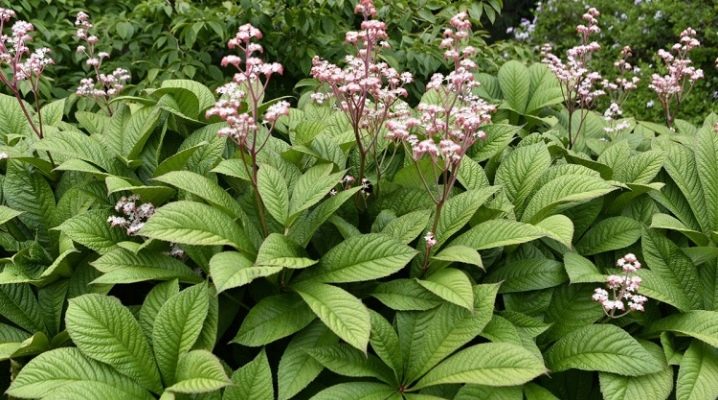
If you dream of decorating your own garden with an extraordinary exotic culture, then you should take note of Rogersia. It is a graceful but often underestimated ornamental plant that is not demanding and can captivate with its unique flowers and gorgeous leaves.
Rogersia can grow successfully in the shade, places with high levels of humidity, in the immediate vicinity of water bodies, in the vicinity of other moisture-loving plants... In its natural environment, as a rule, you can see it in swamps, in thickets.
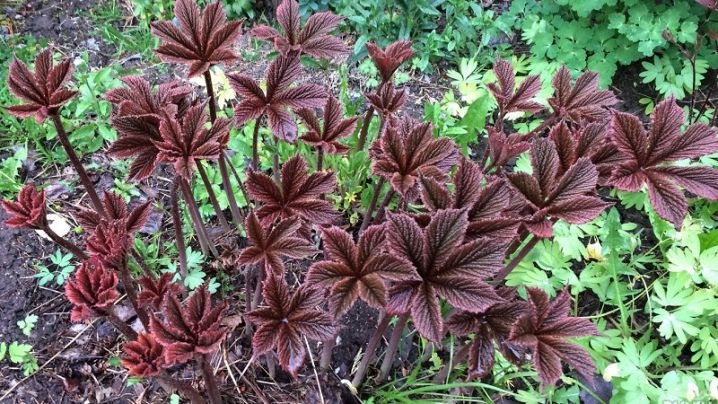
Description
Rogersia flower is a perennial bush and belongs to the Stonefragment family... 6 species are related to it, which are found in the natural environment: in forests with a humid climate and near streams in the Himalayas (in Nepal, China). The bush has a tap root system.
Together with inflorescences, the height of the shrub is up to 1 m 20 cm -1 m 50 cm. The main decorative detail of the plant is its foliage up to 0.5 m in diameter. The leaves are on elongated petioles. They have a rich green color, but are reddish. They can often change colors throughout the year. In appearance, the leaves can be confused with chestnut leaves. This culture begins to bloom in July and does not stop for 30 days. During this period, a group of paniculate inflorescences rises above the bush, which consist of a large number of small flowers. The petals can be painted in interesting colors: pink, white, like snow, light brown or slightly green. Pleasant aromas emanate from the flowers.
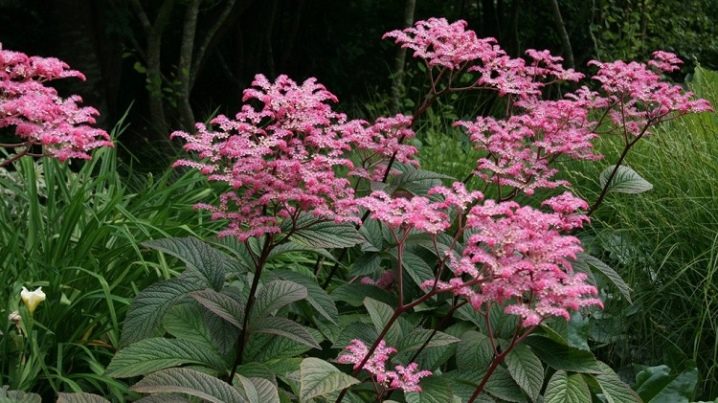
Types and varieties
Of the 9 available varieties of this plant, the most common are such as horse chestnut, stool, elder, feathery rogers. Let's analyze all these types in more detail.
Horse chestnut
This is one of the most common species in European countries and here... In height, it can grow from 80 cm to 1 m 80 cm, peduncles are also quite high - from 1 m 20 cm to 1 m 40 cm. This rogers got its name for its similarity to horse chestnut leaves. The greenery of a flowering plant is formed from rhizomes on long cuttings and has a seven-fingered shape. A distinctive feature of the species is the amazing color of the leaves. When blooming, they have a bronze tint, but gradually acquire a green color. They can be up to 50 cm in diameter in size. The flowers, as a rule, are white or light pink, united in small inflorescences. In its natural environment, it is distributed in the mountains of the PRC. There are few varieties of this Rogers variety, they are mainly used for hybridization.
- "Henry" - Sometimes you can see the name "Henry's Rogers", a tall species of flowering plant with pale pink flowers.
- Henricii ("Henrici" or "Henrici") - this variety is sun-resistant. In the spring, its leaves have a light shade of brown, and in the summer they acquire a bright green color, which looks interesting in different flower arrangements.
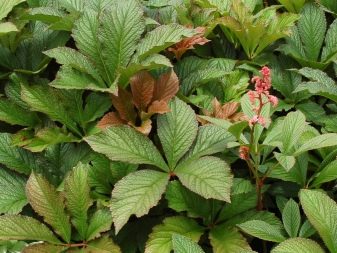
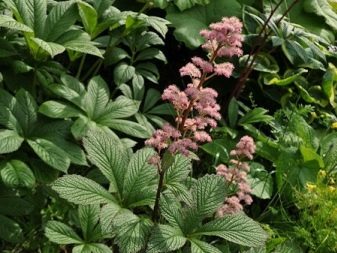
Rogers feathery
In its natural environment, this plant grows in the PRC, in the Yunnan province.... It reaches a height of 70 cm, but during the period of intense flowering it can grow up to 1 m 20 cm. This type of rogers got its name due to the shape of its leaves - they are pinnately-divided. They can reach 30 cm in diameter.When blooming, all leaves are purple in color, which turns into a dark green over time. It blooms in July with white or pale pink medium-sized flowers, which are combined into compact inflorescences.
Let's list the main varieties:
- Alba ("Alba") - this species has green leaves and white, like snow, or flowers with a yellowish tint;
- Cherry Blush - large textured foliage, which has a bronze color in spring and autumn, and pink inflorescences;
- Elegans ("Elegance") - this variety is characterized by the presence of pink flowers;
- Fireworks - one of the most colorful varieties, which stands out with colorful flowers of red-cherry or pink color, the leaves also surprise with their variety of shades: from bronze to bright green;
- Superba - the bush is low, the leaves are bronze in the spring, the flowers are pink;
- Chocolate Wings ("Chocolat" or "Chocolate Wings") - the leaves in spring and autumn impress with their intense chocolate color, and the inflorescences range from pale pink to wine red;
- Bronze Peacock - large variety (grows up to 1.5 m in the first 3 years of life), cream flowers, leaves change color from pink to green or (later) cream.

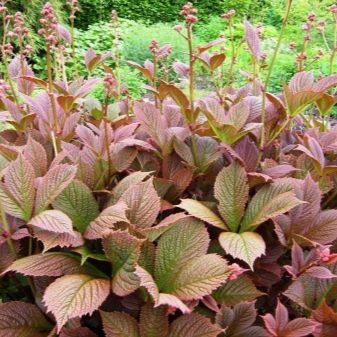
Rogers Elderberry
This type of flowering plant is very rare in flower gardens and dachas in the Russian Federation, since these flowers are more demanding for heat and do not tolerate cold... The maximum height of this rogers is only 70 cm, and in contrast to other species, it has a dissected leaf shape, which is similar to elderberry. The inflorescences grow up to 1m 20 cm and luxuriously rise above the greenish-bronze leaves. The plant blooms with white or pink inflorescences.
Elderberry Rogers varieties:
- Red skin - a variety with reddish-bronze leaves, blooms with white inflorescences with a smoky bloom;
- Kupferschein - a kind with pale yellow flowers.

Rogersia podophyllum (Japanese or hundred-leafed)
It grows rapidly and is especially undemanding to moisture. It can reach a height of 1 m 50 cm. The leaves have a luster and bronze color. Blossoms in a creamy green group of flowers.
Varieties of podophyllum Rogers:
- Big mama - a rather large species with bronze-colored leaves large in diameter;
- Red leaf - the leaves of this variety have a chocolate color with a reddish tint;
- Pagode - has the longest flowering period, the flower has a white tone.

Landing
When choosing a landing site, you should take into account all the subtleties.
- Avoid swampy areas because stagnant water leads to rotting of the root system.
- So that the plant constantly pleases with beauty, the earth must be saturated with humus.
- Landing is in progress in early spring.
- Into the fertilized ground rhizomes deepen by 5-9 cm. A mixture of humus and manure is placed in the pit. Sand drainage is placed at the bottom.
- After planting and mulching the earth is covered with fine bark.
- After a few years, the shrub will reach a decent size. This is what must be taken into account when landing.
Most of the Rogers species are available for breeding on the lands of the Moscow Region, Siberia and the Urals. This is due to its high resistance to frost. Flower growers living in the Moscow region need not think about how an exotic plant will survive the Russian winter. In this area, you only need to protect the bushes with non-woven fabric, and in the case of a little snowy winter, add an additional layer of organic fertilizer or fertile soil. This will prevent the plant from freezing.
In Siberia, it is also possible to grow an exotic flower. In warm regions, you don't even need to use the shelter in winter. In areas with harsher climates, all stems should be cut, leaving only 10 cm from the ground. It is imperative to prepare pine needles or crushed straw for shelter. It will be useful to cover with polyethylene film, the main thing is to leave room for the unhindered passage of air masses. In the Urals, Rogers practically does not reach unprecedented heights.
Usually the plant is not tall, but it is not inferior in flowering to bushes located in more favorable regions. All of the above recommendations are also relevant for this territory.
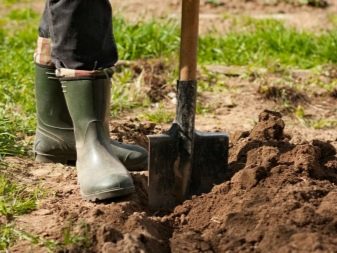
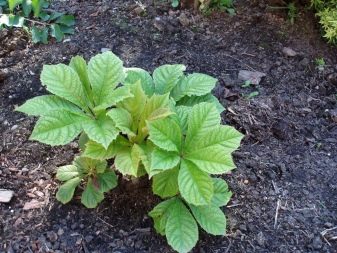
Care
Conditions
Rogers requires fertile soil containing trace elements: sulfur, copper, phosphorus, zinc. Let's mark some moments of leaving.
- Rogersia does not bloom or grow. It is necessary to apply nitrogen fertilizers to the soil.
- With a deficiency of nutrients, the buds containing flower rudiments are not laid, the flowering shoot is not formed or is weakened. An overabundance of nitrogen-containing substances leads to an exorbitant growth of green mass to the detriment of flowering. To stimulate the latter, it is necessary to feed the Rogers in May-June with phosphorus-potassium fertilizers, designed to slow down or accelerate the formation and growth of the plant.
Deficiency of moisture, rare watering is badly reflected on the development of flower buds. When Rogersia regularly lacks fluid, the leaves fly around, do not grow to their normal varietal size, and flower buds do not form.

Watering
The bush is very fond of water. In particular, it is necessary to increase irrigation in hot weather. When the sun is hot outside, it is advisable to moisten the plant at least 2 times in 7 days. For this, you can use warm or cool water. Based on street conditions, the frequency of irrigation is adjusted. When the weather is rainy, you can water less or stop this process for a while.
Before covering the plant for the winter, it must be thoroughly moistened. Such watering is carried out under each shrub, spending at least 3 buckets of water for this. This procedure is required for the rogers to form flower buds. The same irrigation must be carried out with the arrival of spring. As a rule, this time falls on the beginning of April.
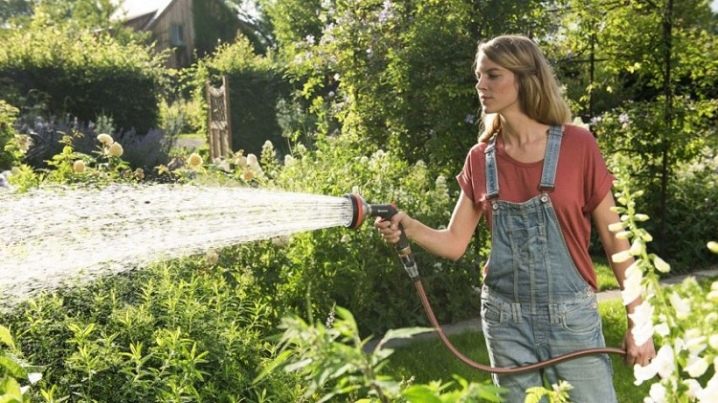
Top dressing
In general, the flower is able to grow on poor soil. But in order to grow a very strong and healthy plant, it should be fed. They practice exclusively nitrogen-phosphorus-potassium fertilizers. Saturate them twice a season. The first application of top dressing is performed before flowering, the second - at the end. If you choose organic fertilizer, you can use mullein, bird droppings.
To prepare a mullein mixture, you must do the following:
- take a bucket, fill it halfway with cow dung;
- add water so that the bucket is full;
- stir the contents, cover with a lid;
- leave to ferment for 2 weeks.
Before watering, dilute 2 liters of finished fertilizer with a whole bucket of water. Similarly, chicken droppings can be used for feeding:
- take a bucket, fill it 1/3 with fresh and dry chicken droppings;
- add water;
- leave the fertilizer to ferment for 10 days;
- as fermentation ends, dilute 0.5 liters of droppings in a bucket of water.

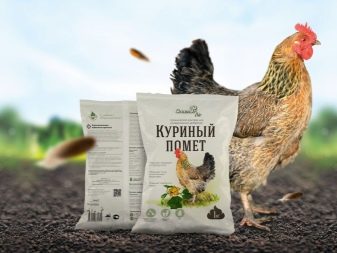
Wintering
This plant, which loves warmth, is able to withstand cold temperatures up to -25 C. If the bush is properly prepared for the winter period, then it is able to siphon without problems in the open field. In late autumn, cut off all the leaves together with the stems almost at the root, and then cover the area with a thick layer of mulch: sawdust, rotted manure, fallen dry leaves or peat.
But if the winter is supposed to have little snow, then before powdering the area with mulch, it must be covered with a non-woven polypropylene fabric with a density of at least 40-60 g / m2... In the spring, it will help protect plants from recurrent frost.
You can not cover the shrub with a film, because thanks to it, a greenhouse effect is created, to which the flower responds very negatively.
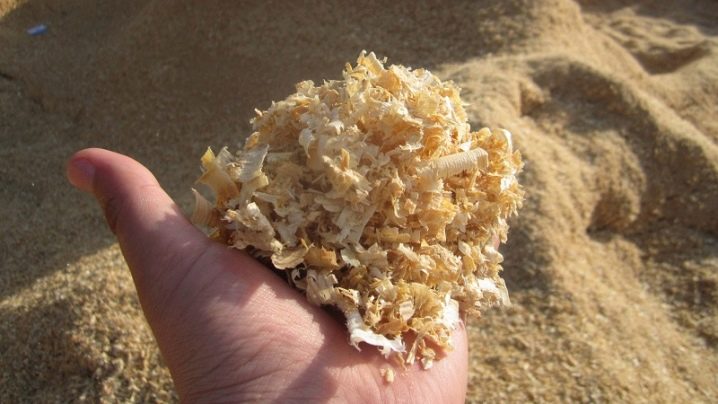
Reproduction
Rogersia can be propagated by seed and dividing the bush. The first technique is not very popular, since the seeds of this flower are characterized by low germination. In addition, hybrid varieties in the process of seed propagation lose the varietal properties of the parent plant.
- Breeding from seeds... First of all, fill the planting box with moistened seedling soil saturated with organic matter and plant the seeds in it. Harvest crops where the ambient temperature is about 0 C for two weeks. Then transfer them to a warm place (10 to 15 C) and maintain a high level of humidity.When the first shoots appear, they will certainly be fertilized. Seedlings grown up to 10-15 cm dive into personal small cups or pots. In the fall, seedlings are transplanted into the garden.
- Division of the bush. The bush is divided in the fall. Remove the horizontal root of the parent shrub from the ground and divide it into segments ranging in size from 8 to 10 cm. Treat them with a growth stimulator and plant them in a container filled with a substrate that includes nutrient soil, peat and sand in a 1: 1: 1 ratio. into the ground by 50–70 mm and remove in a cool place (5 to 10 C), there, keep them there for about 4 months until sprouts appear. Transplant specimens about 50 mm high in pressed peat glasses, and they can be dived into the garden in the last days of May or early June.
- Cuttings... Cuttings are carried out in the summer. Cut a few petioled leaves and place them in any growth promoting product for 12-15 hours. Then plant the cuttings for rooting in a nutritious moist seedling soil.
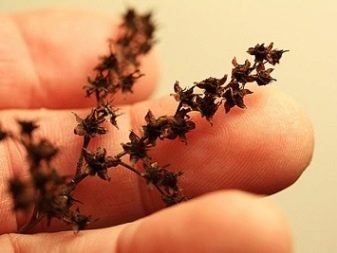

Diseases and pests
In a rainy year and in low-lying areas, Rogers suffers from fungal diseases. Despite the resistance of the culture to diseases and parasites, with excess moisture on the bushes, a parasitic rust fungus, slugs and snails that prefer vegetation in shaded areas can start. Rot can be recognized by yellowing and death of foliage, dark spots, and a suspension of growth intensity.
A shrub with root rot is pulled out, unhealthy parts of the rhizome are cut out, treated with chemicals to combat fungal plant diseases, and transplanted.
They fight insects by means of mechanical, folk methods (dry mustard) or chemical preparations ("Thunderstorm").
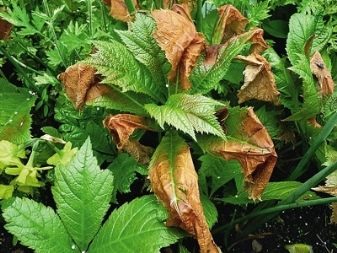

Application in landscape design
Rogersia is extremely gorgeous even without the flowers. It can be bred both separately and in groups. A part of the garden that is in the shade is perfect for her. Such a perennial plant looks great near a juniper or fern. And also looks extremely impressive near low plants (astilbe, epimedium, ostrich and tiarella), coniferous shrubs and dwarf trees.
Large groups of Rogersia flowers have the ability to be a catchy accent of a whole composition, and irises, daffodils and hosts will look amazing against the background of dense foliage. It can be planted in flower beds, rocky hills, in gardens, and this plant is also practiced for single plantings.


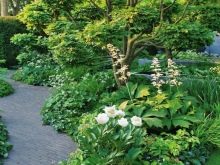







































































































The comment was sent successfully.